Here is some quiet, contemplative Christmas music:
Saturday, December 17, 2011
Monday, December 12, 2011
Wondrous Christmas Music
One thing I love about the Christmas season is the glorious music we can sing and listen to. And the Mormon Tabernacle Choir is right up there, especially their annual Christmas concert. Oh how I would love to attend one of these live--Suzanne tried to get tickets this year for my birthday, but no luck. I'll have to content myself with getting and watching the DVDs.
Here are a few of my favorites, leading off with perhaps my all time favorite:
Here is the opening processional from a few years ago. If this doesn't get the energy flowing I don't know what will:
This one took a few listenings to grab me, so hang with it. About 2:30 it really kicks up a notch:
The finale "Angels from the Realms of Glory" from last year's concert (Miriam and Magdalena should enjoy the dancers):
The same finale from the prior year. Note the choir member with tears at 4:02. I can only imagine how powerful this rendition is live:
Mack Wilberg, the arranger for these selections, is my all time hero. I love pretty much everything he has a hand in.
I hope you enjoy these as much as I do, and Merry Christmas!
Here are a few of my favorites, leading off with perhaps my all time favorite:
Here is the opening processional from a few years ago. If this doesn't get the energy flowing I don't know what will:
This one took a few listenings to grab me, so hang with it. About 2:30 it really kicks up a notch:
The finale "Angels from the Realms of Glory" from last year's concert (Miriam and Magdalena should enjoy the dancers):
The same finale from the prior year. Note the choir member with tears at 4:02. I can only imagine how powerful this rendition is live:
Mack Wilberg, the arranger for these selections, is my all time hero. I love pretty much everything he has a hand in.
I hope you enjoy these as much as I do, and Merry Christmas!
Saturday, December 10, 2011
Return to Slovakia -- Iron Curtain, Part 5
We continued with the rental car, driving from Berlin down through southern Germany, Austria, and into Slovakia. We stopped in Prievidza to visit and spend the night with Juraj Bubnas and his family. Juraj is a distant cousin of Suzanne's and their family was so welcoming. Prievidza is a nice city in central Slovakia, and Juraj's family lived in a nice home. We toured the nearby Bonice castle with them and enjoyed a pleasant dinner and singing on their backyard patio.
Juraj Bubnas and family.

We continued eastward and enjoyed hiking up to Spis castle, an impressive edifice, though a bit mismanaged and not quite tourist friendly. For example, there was loud pop music playing in a concession area in the center of the castle, and we found the gate locked as we attempted to exit the castle on the path back down.

While there were no expressways in the eastern half of the country, we did find the roads decent and well paved. However, the Slovaks are dangerous drivers, routinely passing in curves and other blind spots. Several times we came upon accident scenes. It was rather unnerving. One strategy was to follow behind another vehicle so at least you wouldn't be the one in the head-on collision.
We took a chance and checked into the Hotel Chemes upon arrival in Humenne in the far east of Slovakia. It had a few rough edges but was quite satisfactory, given the very reasonable price. In fact, prices seemed depressed for everything in Slovakia. Unlike, say Prague, Slovakia is a very low key and economical destination for tourists.
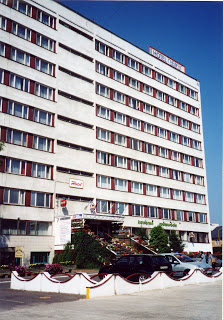
Once again we were welcomed with opened arms by many of Suzanne's cousins in the Humenne and Poruba areas. What gracious and friendly people. They held an outdoor party for us and numerous cousins came by. Bridget and Jeremy were particularly popular speaking Russian to those of our generation and older (who learned Russian rather than English).
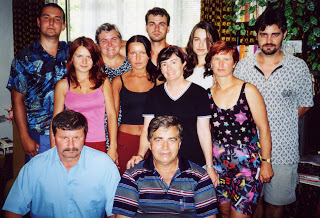
It had been five years since our first trip to Slovakia, and we felt like the country was definitely moving up in the world. Still off the beaten path but a more pleasant, upbeat feel to it.
Here is a blog post by Bridget describing experiences from this trip.
And last year we returned for a quick drive through Hungary and Slovakia, again visiting the same cousins. I wrote several blog posts (here, here, and here) about that, as did Suzanne.
There is a lot to like about Slovakia, and the other former Eastern Bloc countries. Some day we'd like to go back and spend more time hiking and sightseeing.
Juraj Bubnas and family.
We continued eastward and enjoyed hiking up to Spis castle, an impressive edifice, though a bit mismanaged and not quite tourist friendly. For example, there was loud pop music playing in a concession area in the center of the castle, and we found the gate locked as we attempted to exit the castle on the path back down.

While there were no expressways in the eastern half of the country, we did find the roads decent and well paved. However, the Slovaks are dangerous drivers, routinely passing in curves and other blind spots. Several times we came upon accident scenes. It was rather unnerving. One strategy was to follow behind another vehicle so at least you wouldn't be the one in the head-on collision.
We took a chance and checked into the Hotel Chemes upon arrival in Humenne in the far east of Slovakia. It had a few rough edges but was quite satisfactory, given the very reasonable price. In fact, prices seemed depressed for everything in Slovakia. Unlike, say Prague, Slovakia is a very low key and economical destination for tourists.

Once again we were welcomed with opened arms by many of Suzanne's cousins in the Humenne and Poruba areas. What gracious and friendly people. They held an outdoor party for us and numerous cousins came by. Bridget and Jeremy were particularly popular speaking Russian to those of our generation and older (who learned Russian rather than English).
It had been five years since our first trip to Slovakia, and we felt like the country was definitely moving up in the world. Still off the beaten path but a more pleasant, upbeat feel to it.
Here is a blog post by Bridget describing experiences from this trip.
And last year we returned for a quick drive through Hungary and Slovakia, again visiting the same cousins. I wrote several blog posts (here, here, and here) about that, as did Suzanne.
There is a lot to like about Slovakia, and the other former Eastern Bloc countries. Some day we'd like to go back and spend more time hiking and sightseeing.
Monday, December 5, 2011
Side trip to Poland -- Iron Curtain, Part 4
We left Russia, flying from Moscow to Prague. We spent several days in Prague, the well preserved tourist magnet in the Czech Republic. People said Prague should be visited before it became too popular, but we were too late. It is a wonderful city, but crowded with tourists, and sprinkled with pickpockets. One tried to reach into my pack on a subway.
From Prague we took the train to Berlin. There we visited the Checkpoint Charlie site and museum and remnants of the Berlin Wall, both on the border of the former West and East Berlin. You could still see the difference in affluence between the two sectors, though there was rampant construction in the downtown sector of the east--cranes everywhere. Berlin seemed a vibrant, multicultural place.
In Berlin, we rented a car for a day trip to Poland. I have German ancestors who lived in Pommerania, the northwest section of the country, near Kolberg, in a small village called Moitzelfitz. I only had a small 100+ year-old map showing the German villages and roads from that time, but we managed to navigate our way there.
Here is the city limit sign, showing the present Polish name.
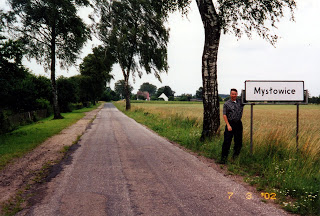
The main (only?) street through town.

The old German church was in the center of town, and in disrepair (a new church was next door).
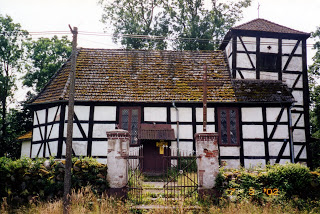
This plaque was on an inside wall. It commemorates the fallen from the war of 1870-71. Family legend has it that my ancestor fled to America to escape military service, perhaps this very war.
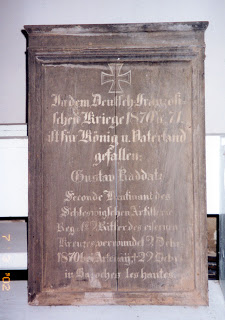
There was a fairly modern cemetery on the outskirts of town, but all the graves were Polish. We tried to communicate with some villagers, but nobody spoke English or German, and the minimal Polish phrases in our tour book were insufficient. Eventually, someone fetched a youngish man named Martin, and he spoke English or German, and he was happy to show us around a bit. He took us to the old German cemetery, which was rather broken up and neglected.
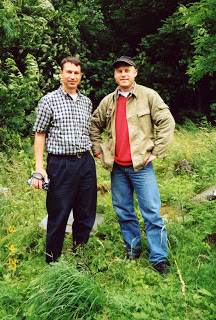
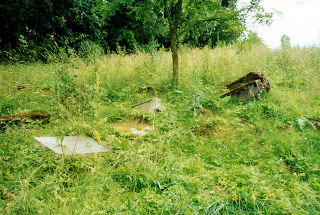
At the end of World War 2 the border between Poland and Germany was moved many miles west. Pommerania became part of Poland, and the native German people moved west as well. Martin said there were no more German people left in this part of the country--they had all gone.
From Prague we took the train to Berlin. There we visited the Checkpoint Charlie site and museum and remnants of the Berlin Wall, both on the border of the former West and East Berlin. You could still see the difference in affluence between the two sectors, though there was rampant construction in the downtown sector of the east--cranes everywhere. Berlin seemed a vibrant, multicultural place.
In Berlin, we rented a car for a day trip to Poland. I have German ancestors who lived in Pommerania, the northwest section of the country, near Kolberg, in a small village called Moitzelfitz. I only had a small 100+ year-old map showing the German villages and roads from that time, but we managed to navigate our way there.
Here is the city limit sign, showing the present Polish name.
The main (only?) street through town.
The old German church was in the center of town, and in disrepair (a new church was next door).
This plaque was on an inside wall. It commemorates the fallen from the war of 1870-71. Family legend has it that my ancestor fled to America to escape military service, perhaps this very war.
There was a fairly modern cemetery on the outskirts of town, but all the graves were Polish. We tried to communicate with some villagers, but nobody spoke English or German, and the minimal Polish phrases in our tour book were insufficient. Eventually, someone fetched a youngish man named Martin, and he spoke English or German, and he was happy to show us around a bit. He took us to the old German cemetery, which was rather broken up and neglected.
At the end of World War 2 the border between Poland and Germany was moved many miles west. Pommerania became part of Poland, and the native German people moved west as well. Martin said there were no more German people left in this part of the country--they had all gone.
Sunday, December 4, 2011
The Tree Hunt
Each December since we have lived in Oregon we have driven five miles (plus or minus) to a local Christmas tree farm to select and cut down our Christmas tree. It has been a family outing and tradition. Over the years we have experienced a variety of weather during these outings--rain, sun, cold, balmy, dry, wet (muddy). I don't recall snow, but all the above is possible in December.
There must be half a dozen or more different farms we have visited, with varying features. The last several years we have visited the Furrow Farm, about six miles distant and very convenient. They have a shed where hot chocolate is served, and a tractor pulls a hay wagon where we can ride to the tree area. This year we added a short hike in the nearby woods.
Here are the men of the family poised to snag a tree in 2002:

In the hot chocolate shed in 2004:

The Palmers were visiting in 2006:

And again in 2009:
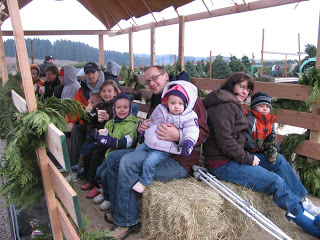
It was a beautiful balmy day this weekend:
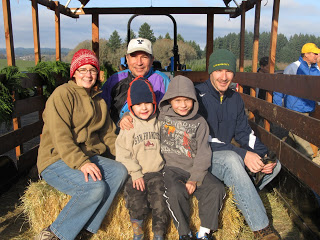
We opted for a table-top tree this year, which was easily handled by Jonah and Eli.

So it has been fun and memorable over the years to experience this with our children, and now our grandchildren. Last year we never got around to getting a tree, as Suzanne was out of town helping with baby Shiloh until shortly before Christmas--and I confess it was a relaxing change of pace. This year I actually started thinking about buying an artificial tree. Perhaps the live tabletop tree size is a good compromise so we can enjoy the tree hunt with the grandkids, but have less hassle dealing with the tree. We'll see.
There must be half a dozen or more different farms we have visited, with varying features. The last several years we have visited the Furrow Farm, about six miles distant and very convenient. They have a shed where hot chocolate is served, and a tractor pulls a hay wagon where we can ride to the tree area. This year we added a short hike in the nearby woods.
Here are the men of the family poised to snag a tree in 2002:
In the hot chocolate shed in 2004:
The Palmers were visiting in 2006:
And again in 2009:
It was a beautiful balmy day this weekend:
We opted for a table-top tree this year, which was easily handled by Jonah and Eli.
So it has been fun and memorable over the years to experience this with our children, and now our grandchildren. Last year we never got around to getting a tree, as Suzanne was out of town helping with baby Shiloh until shortly before Christmas--and I confess it was a relaxing change of pace. This year I actually started thinking about buying an artificial tree. Perhaps the live tabletop tree size is a good compromise so we can enjoy the tree hunt with the grandkids, but have less hassle dealing with the tree. We'll see.
Saturday, December 3, 2011
Unfortunate name associations
My siblings and parents were discussing common meanings for their given names, and how they grow weary of hearing the same jokes about them from different people. June, Chuck, Wendy, Barry, Sandy, Glade, Kevin.
Then, there is Craig, which doesn't seem to have such a disadvantage. Except for the fact it is my middle name so my life has always been complicated by that. Like being called "Alan" by people who don't know me, or having to fill out forms with first name, middle initial, and last name.
But when we moved to Oregon back in the 80's there was a prominent local TV and radio personality named Craig Walker. Now, every time my name was spoken in public everyone would turn around to look at me. Many would ask if I was THE Craig Walker. I do suspect I got special treatment a time or two from people or businesses who weren't sure. But overall it was a burden I didn't care for at all. Sometimes complete strangers would call for me on the phone, a few times in the middle of the night. We found out that Craig Walker was only his stage name, and learned what his real name was. So we would tell people my name wasn't his real name anyway.
I recall my first business trip out of state, and checking into a hotel in San Jose, CA. I was pointedly relieved that I could approach the check-in desk and announce my name with impunity. What a carefree feeling! So you can imagine how appalled I was when the clerk immediately asked if I was the famous Craig Walker from Portland! Arghhh!!
The famous Craig Walker has since retired from public life, so it is increasingly rare that I get comments. In any event, I have become hardened to them and it is no longer an issue.
By the way, that is why my blog is titled "A" Craig Walker, not "The" Craig Walker.
Then, there is Craig, which doesn't seem to have such a disadvantage. Except for the fact it is my middle name so my life has always been complicated by that. Like being called "Alan" by people who don't know me, or having to fill out forms with first name, middle initial, and last name.
But when we moved to Oregon back in the 80's there was a prominent local TV and radio personality named Craig Walker. Now, every time my name was spoken in public everyone would turn around to look at me. Many would ask if I was THE Craig Walker. I do suspect I got special treatment a time or two from people or businesses who weren't sure. But overall it was a burden I didn't care for at all. Sometimes complete strangers would call for me on the phone, a few times in the middle of the night. We found out that Craig Walker was only his stage name, and learned what his real name was. So we would tell people my name wasn't his real name anyway.
I recall my first business trip out of state, and checking into a hotel in San Jose, CA. I was pointedly relieved that I could approach the check-in desk and announce my name with impunity. What a carefree feeling! So you can imagine how appalled I was when the clerk immediately asked if I was the famous Craig Walker from Portland! Arghhh!!
The famous Craig Walker has since retired from public life, so it is increasingly rare that I get comments. In any event, I have become hardened to them and it is no longer an issue.
By the way, that is why my blog is titled "A" Craig Walker, not "The" Craig Walker.
Friday, December 2, 2011
Into the Heart of the Beast--Iron Curtain, Part 3
We had another opportunity to venture behind the former Iron Curtain in June, 2002, after Bridget and Jeremy moved to Moscow, Russia, and provided a reason for the trip and a home base with tour guides. This time, we traveled right into the very heart of the beast, of the former Soviet Union itself.
Things looked exotic right off the bat after landing at Sheremetyevo Airport and seeing the words on signs in the Cyrillic alphabet. We had immediate exposure to the former Communist influence in the terminal, with the horrid building architecture and the surly employees. In the neighborhoods we noticed a rather scruffy appearance, with weeds growing and unkempt public spaces.
Bridget cautioned us to be careful what we said in public, as well as in their apartment, which they were confident was bugged. (You can read more about that in Bridget's blog here.) It was forbidden to take photographs of some things, such as any underground metro station, which was a shame because they were so ornate and fascinating. On our last day I did venture taking some video shots of one station while coming down the escalator, and a stern lady scolded me for doing so--I just played the dumb tourist.
The first day we went to the city center and toured Red Square. This was the very spot where former Soviet leaders would view military parades, showing off their might to the West. Here was the Kremlin, Lenin's tomb, St. Basil's Church--all so incredibly exotic to me, as one who grew up during and was so influenced by the Cold War.
Red Square and the Kremlin
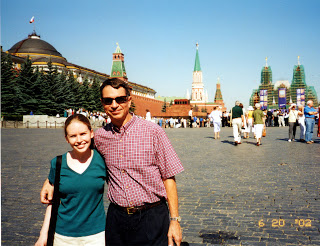
St. Basil's Church on Red Square.

From many vantage points we could see the seven sisters of Stalin across the landscape of the city. These are prominent buildings constructed from 1947 to 1953 and are symbolic of Stalin architecture. Here is one of those buildings, Moscow University.

The onion dome churches were another dominant feature. Amazing that these Russian Orthodox churches, as well as the faith of many in the population, survived so many decades of Communist repression. The famous Moscow Cathedral was demolished by the Communists in 1931, with plans to build a grand Palace of the Soviets, which never happened. The world's largest open air swimming pool was constructed in the perpetually flooded ruins in the 1950's.
We took an overnight train to St. Petersburg (formerly known as Leningrad under the Soviets), spent the full day sightseeing there, and took an overnight train back to Moscow. European influences were prominent in St. Petersburg, a beautiful city and the former capital and home of the Czars.
Cathedral of the Resurrection of Christ in St. Petersburg.
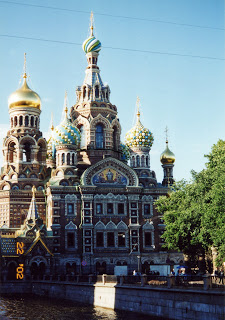
One day Suzanne and I ventured an unguided trip to Sergiev Posad, perhaps 50 miles northeast of Moscow. We navigated the Moscow subway system and found a bus destined to go there. It was a warm, sunny day and we were so thirsty. I purchased a bottle of "Seven-ya" soda pop for the bus ride. It was the most awful tasting imitation of lemon lime soda imaginable. Tasted more like bathroom cleaner, and, as thirsty as we were, we drank very little of it. We were proud of ourselves for pulling off this successful adventure.
Domes of numerous ancient churches in Sergiev Posad.
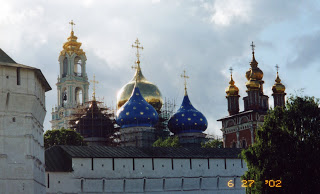
You can't help but notice the impact Word War II had on Russia. It is estimated 20 million Russians died in the conflict. Coming into the city from the airport there are markers showing the maximum advance of the German army. Many cities are designated as "hero cities", such as Moscow, Leningrad, Stalingrad, and many others, due to their defense and suffering during the conflict. There is a prominent museum commemorating the "Great Patriotic War", as they call it. I don't think we Americans can fathom what it was like for them. We visited the museum and it made a strong impression on us.
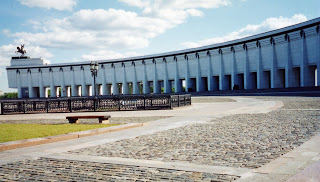
We visited a most unique cemetery in Moscow, where most of the famous Russians are buried. There was a wide variety of styles of monuments on the graves. Nikita Krushchev's marker was black and white, signifying he had good and bad traits. It is noteworthy that he was buried here, rather than the Kremlin, showing he was out of favor at his death.

Western culture is taking some hold in Russia. McDonald's has several restaurants in Moscow, and it is considered upscale to the Russians. It is novel indeed to get service with a smile. We took a special bus to Ikea to enjoy a salmon dinner.

Oh, there is so much more I'd like to share about this memorable trip. But, another time and another post.
Things looked exotic right off the bat after landing at Sheremetyevo Airport and seeing the words on signs in the Cyrillic alphabet. We had immediate exposure to the former Communist influence in the terminal, with the horrid building architecture and the surly employees. In the neighborhoods we noticed a rather scruffy appearance, with weeds growing and unkempt public spaces.
Bridget cautioned us to be careful what we said in public, as well as in their apartment, which they were confident was bugged. (You can read more about that in Bridget's blog here.) It was forbidden to take photographs of some things, such as any underground metro station, which was a shame because they were so ornate and fascinating. On our last day I did venture taking some video shots of one station while coming down the escalator, and a stern lady scolded me for doing so--I just played the dumb tourist.
The first day we went to the city center and toured Red Square. This was the very spot where former Soviet leaders would view military parades, showing off their might to the West. Here was the Kremlin, Lenin's tomb, St. Basil's Church--all so incredibly exotic to me, as one who grew up during and was so influenced by the Cold War.
Red Square and the Kremlin

St. Basil's Church on Red Square.

From many vantage points we could see the seven sisters of Stalin across the landscape of the city. These are prominent buildings constructed from 1947 to 1953 and are symbolic of Stalin architecture. Here is one of those buildings, Moscow University.

The onion dome churches were another dominant feature. Amazing that these Russian Orthodox churches, as well as the faith of many in the population, survived so many decades of Communist repression. The famous Moscow Cathedral was demolished by the Communists in 1931, with plans to build a grand Palace of the Soviets, which never happened. The world's largest open air swimming pool was constructed in the perpetually flooded ruins in the 1950's.
We took an overnight train to St. Petersburg (formerly known as Leningrad under the Soviets), spent the full day sightseeing there, and took an overnight train back to Moscow. European influences were prominent in St. Petersburg, a beautiful city and the former capital and home of the Czars.
Cathedral of the Resurrection of Christ in St. Petersburg.

One day Suzanne and I ventured an unguided trip to Sergiev Posad, perhaps 50 miles northeast of Moscow. We navigated the Moscow subway system and found a bus destined to go there. It was a warm, sunny day and we were so thirsty. I purchased a bottle of "Seven-ya" soda pop for the bus ride. It was the most awful tasting imitation of lemon lime soda imaginable. Tasted more like bathroom cleaner, and, as thirsty as we were, we drank very little of it. We were proud of ourselves for pulling off this successful adventure.
Domes of numerous ancient churches in Sergiev Posad.

You can't help but notice the impact Word War II had on Russia. It is estimated 20 million Russians died in the conflict. Coming into the city from the airport there are markers showing the maximum advance of the German army. Many cities are designated as "hero cities", such as Moscow, Leningrad, Stalingrad, and many others, due to their defense and suffering during the conflict. There is a prominent museum commemorating the "Great Patriotic War", as they call it. I don't think we Americans can fathom what it was like for them. We visited the museum and it made a strong impression on us.

We visited a most unique cemetery in Moscow, where most of the famous Russians are buried. There was a wide variety of styles of monuments on the graves. Nikita Krushchev's marker was black and white, signifying he had good and bad traits. It is noteworthy that he was buried here, rather than the Kremlin, showing he was out of favor at his death.

Western culture is taking some hold in Russia. McDonald's has several restaurants in Moscow, and it is considered upscale to the Russians. It is novel indeed to get service with a smile. We took a special bus to Ikea to enjoy a salmon dinner.

Oh, there is so much more I'd like to share about this memorable trip. But, another time and another post.
Subscribe to:
Posts (Atom)